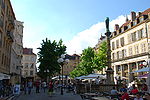County of Metz
Counties of the Holy Roman EmpireCounts of the Holy Roman EmpireHistory of LorraineHistory of Metz
The County of Metz originated from the frankish Metzgau. In the second half of the 9th century it went to the Gerhardiner (de), which held at the same time the County of Paris. Over the Gerhardiner went the County—perhaps even in male lineage—to the Matfriede, which furthermore in 1047 received the title of Duke in Lorraine, namely Gerard IV, Duke of Alsace (c. 1030 – 1070), Seigneur of Châtenois (see also House of Châtenois). The County of Metz stood little time later under the high dignity of the Bishopric of Metz, to which it then integrated itself. From 1189 the city of Metz was a Free Imperial City of the German Holy Roman Empire.
Excerpt from the Wikipedia article County of Metz (License: CC BY-SA 3.0, Authors).County of Metz
Rue des Récollets, Metz Bellecroix
Geographical coordinates (GPS) Address Nearby Places Show on map
Geographical coordinates (GPS)
| Latitude | Longitude |
|---|---|
| N 49.12 ° | E 6.18 ° |
Address
Jardin des plantes toxiques
Rue des Récollets
57014 Metz, Bellecroix
Grand Est, France
Open on Google Maps









